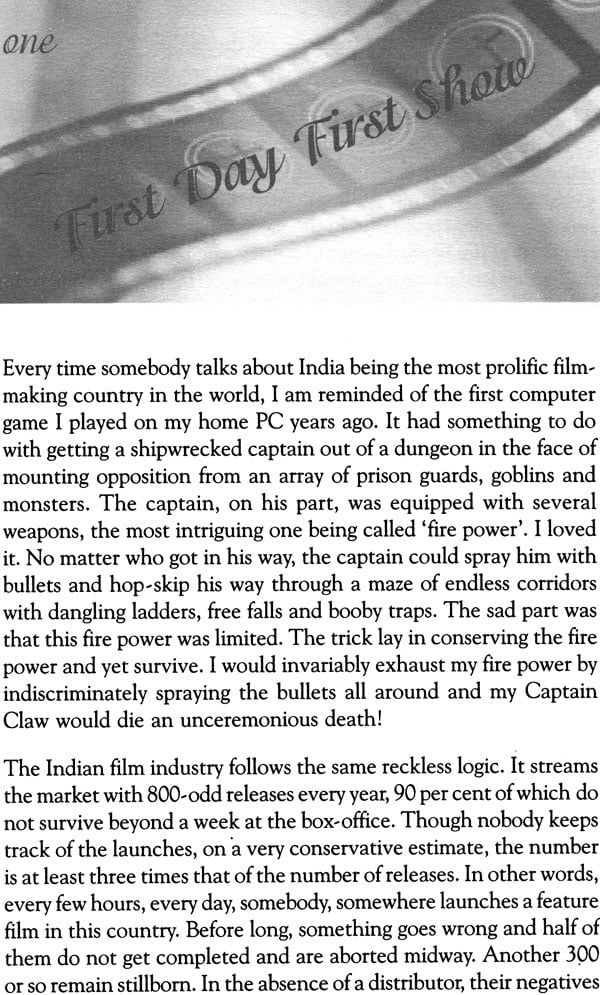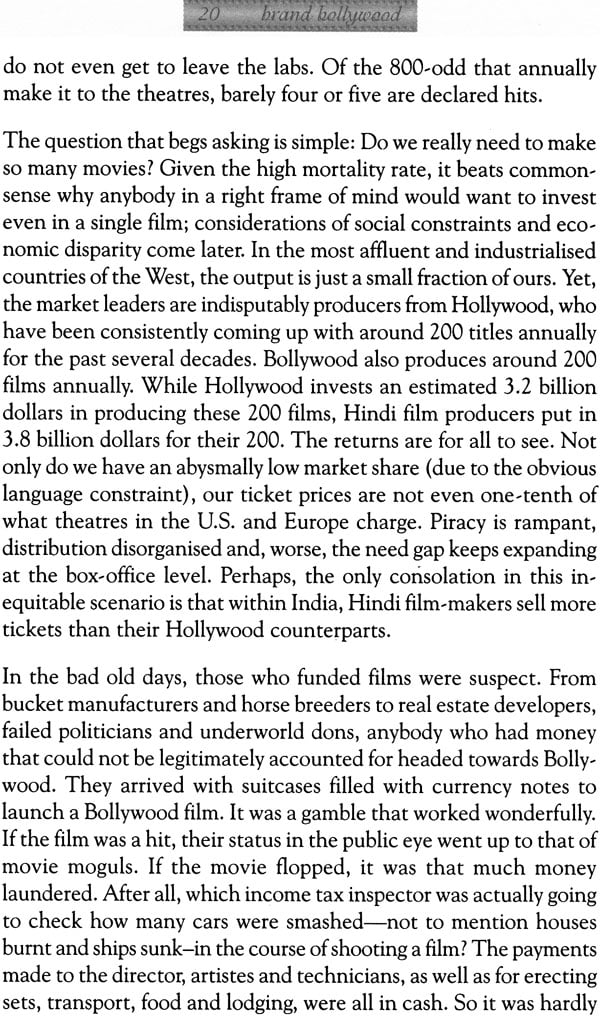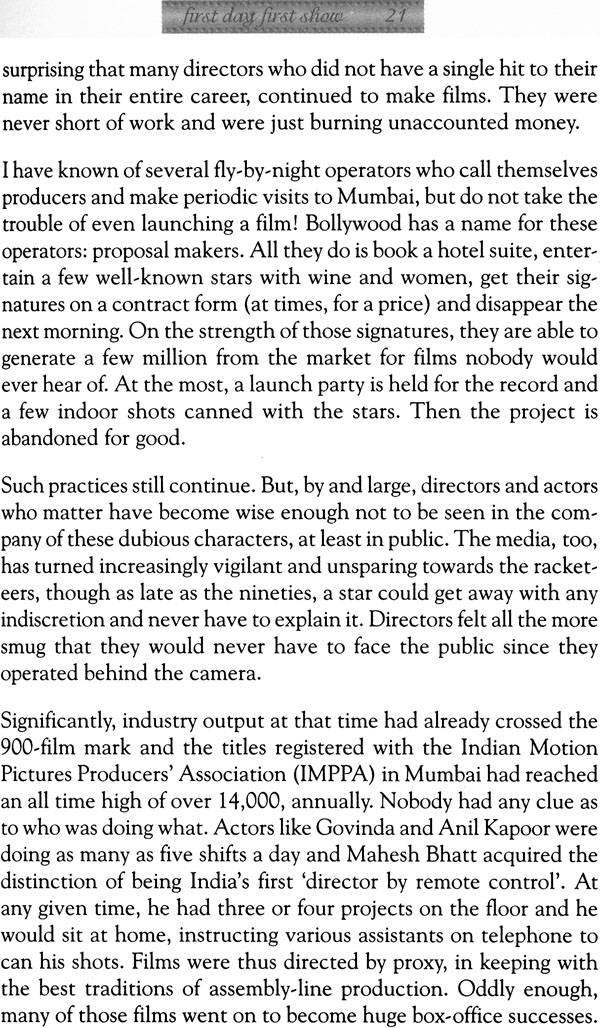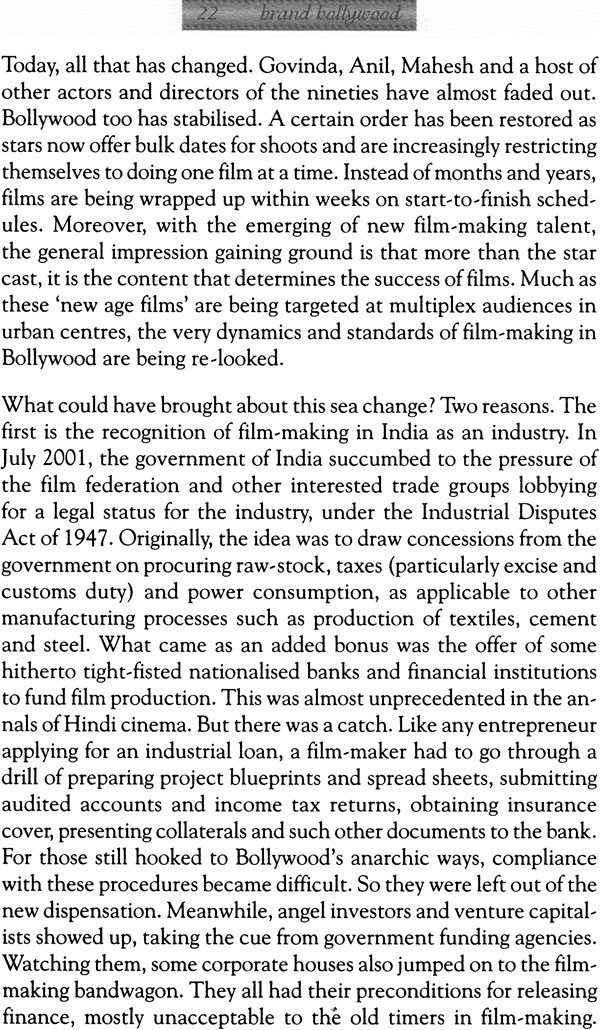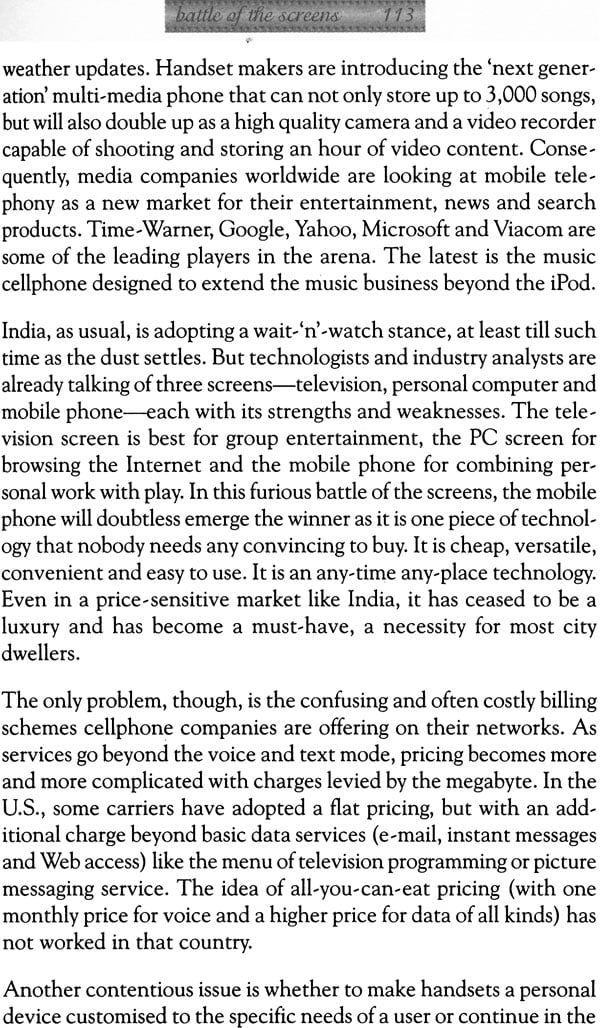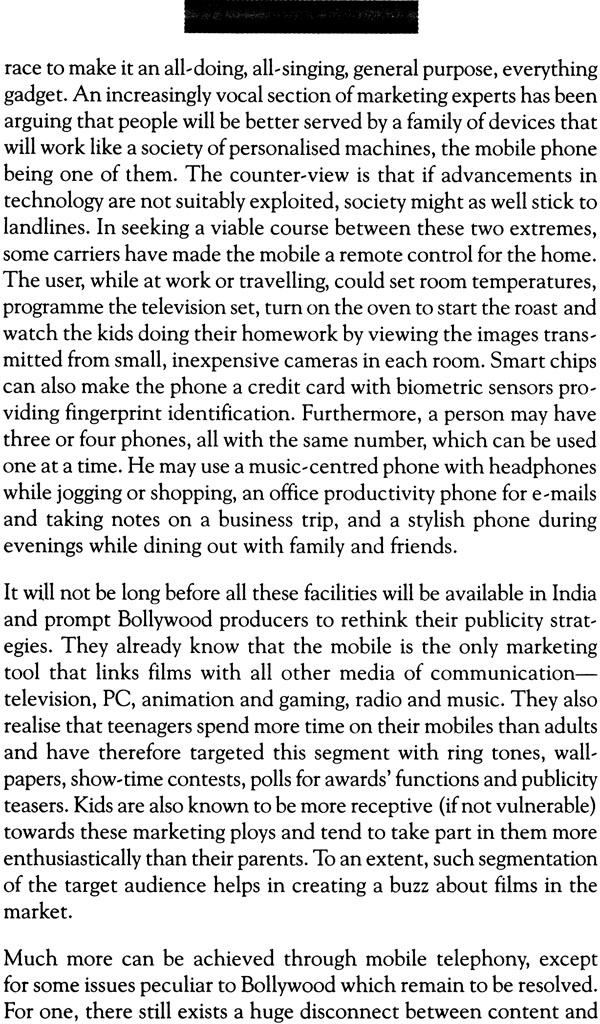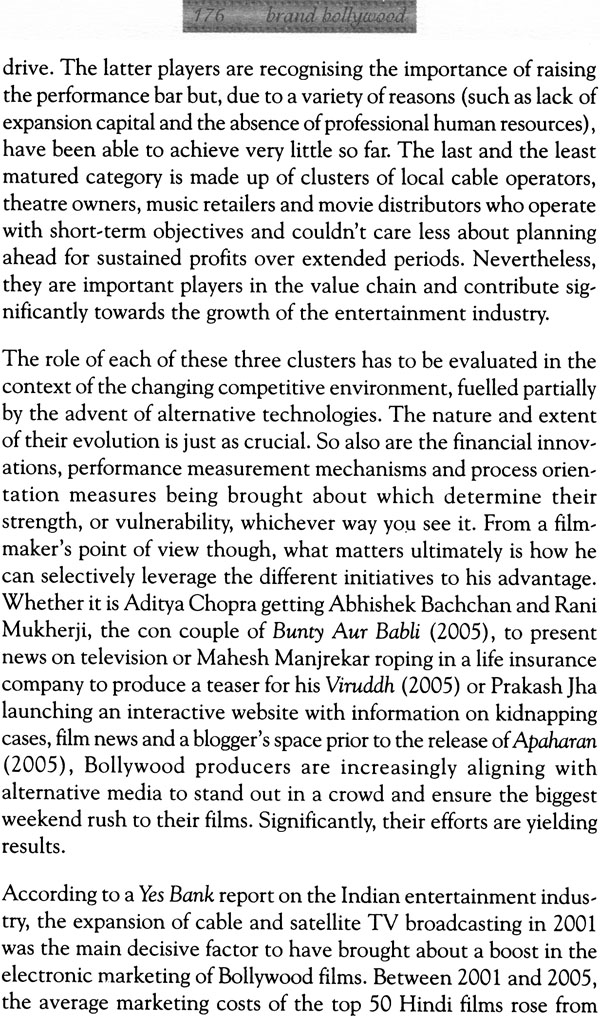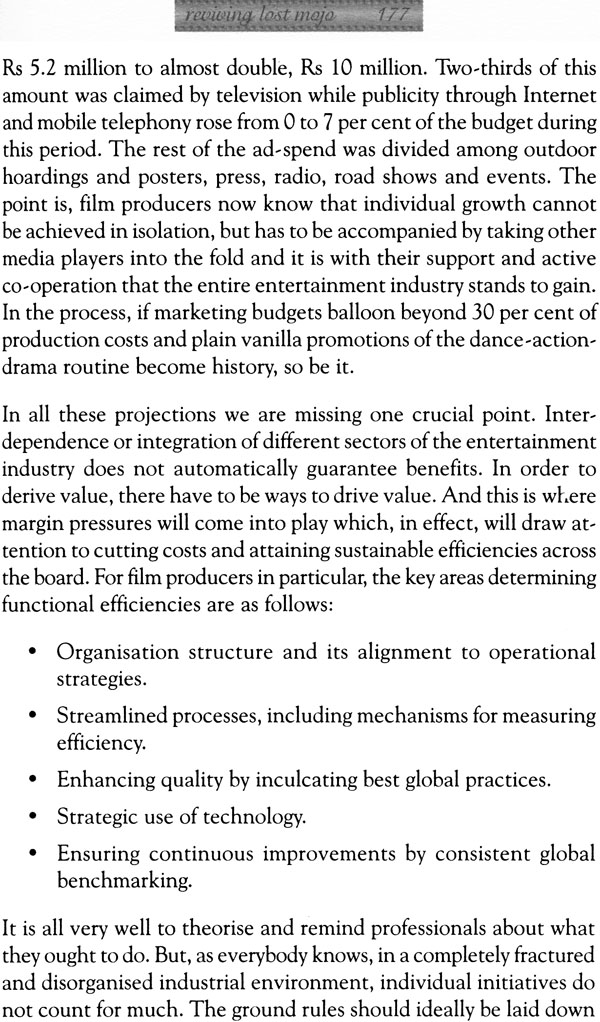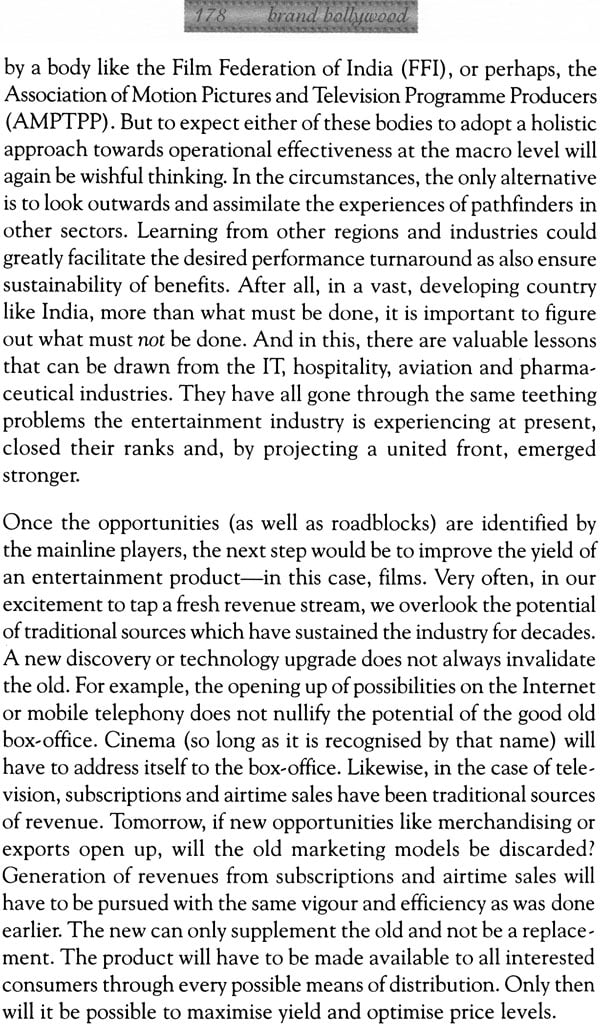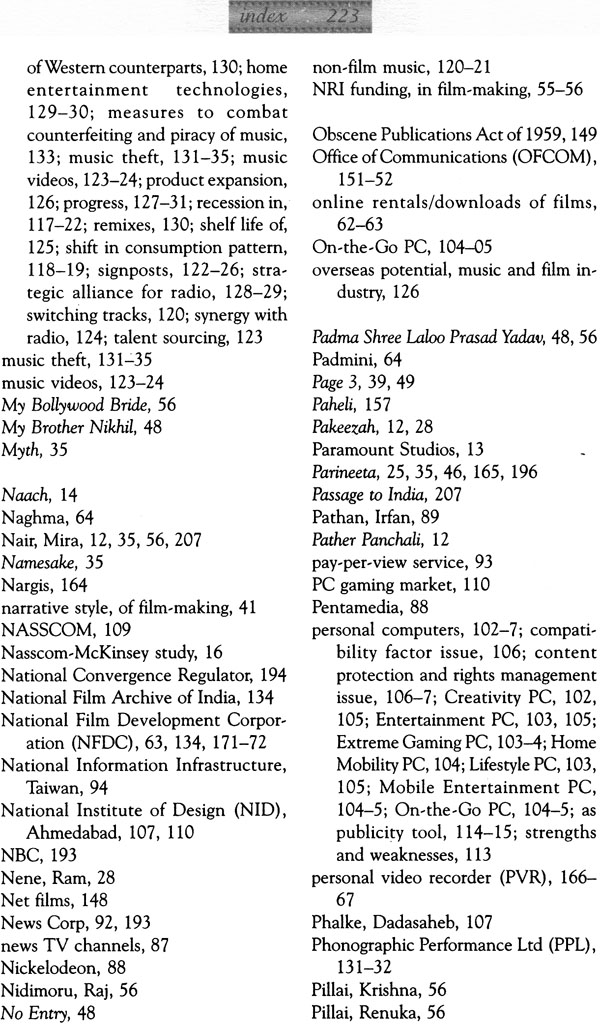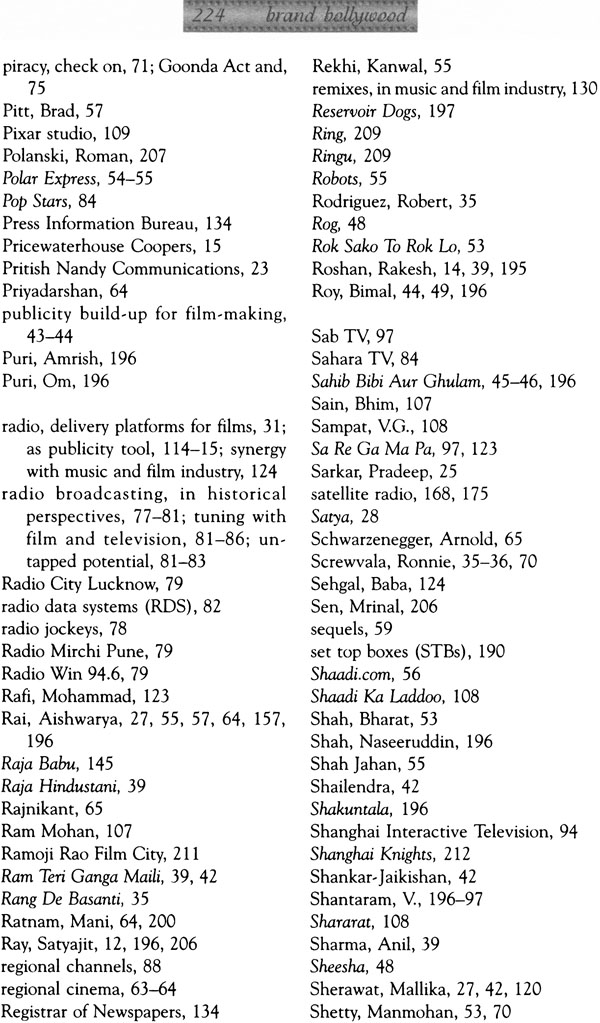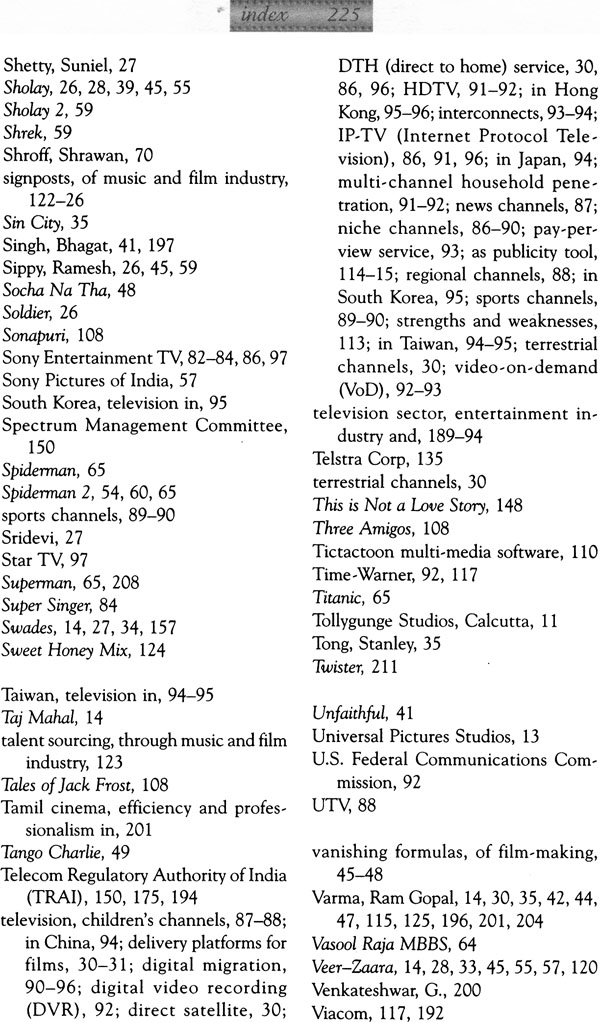
Brand Bollywood A New Global Entertainment Order
Book Specification
| Item Code: | IDJ236 |
| Author: | Derek Bose |
| Publisher: | Sage Publications India Pvt. Ltd. |
| Language: | English |
| Edition: | 2006 |
| ISBN: | 0761935347 |
| Pages: | 226 |
| Cover: | Paperback |
| Other Details | 8.4" X 5.4" |
| Weight | 260 gm |
Book Description
About Author
Derek Bose is a senior journalist and film jurist. He is also the group editor with a leading publishing house in Mumbai, which publishes lifestyle magazines. He has worked as Features Editor with the Press Trust of India, as International Editor or Indian Express and as the South Asia correspondent with Asian Leader, a leading British newspaper. He has been extensively published in various journals and has officiated on the jury of several national and international film festivals. His authored books include Bollywood Unplugged: Deconstructing Cinema in Black and White; Kishore Kumar: Method in Madness; Bollywood Uncensored: What You Don't See on Screen and Why; and Everybody Wants Hits: 10 Mantras of Success in Bollywood Cinema
Apart from his love for cinema, Derek Bose is a keen Sunday painter and has directed several short films including the award-winning documentary, Dance of the Gods.
Back of the Book
Convenient coincidences and glycerine tears, star-crossed lovers and happy endings, mindless songs and energetic dances these elements, and more, have sustained the Bollywood brand of cinema or nearly a century, so much so that it has now found acceptance across continents.
This book is a road map for the-changing entertainment landscape of India. it succinctly outlines how film entertainment in India is no longer just an artistic or creative enterprise. This is due to the rapid convergence of various media-home video, satellite television, radio, Internet, animation and gaming-which determines the successful film-makers will be those who recognise the consolidated potential of these revenue streams as opportunities to be tapped for maximising results-so much so that it would be impossible to produce a flop.
Based on original research and personal interviews and discussions with film-makers, media professionals and market players, this is also baked by solid date from a variety of surveys, audit studies and annual reports available in the public domain. By sifting through and collating inputs from such sources, the author arrives at concrete collating inputs from such sources, the author arrives at concrete conclusions that place the issue of media convergence within the framework of film development-something that has not been attempted before.
Insightful and lucidly written, this book will be of interest to those involved in film/media studies, cultural studies and economics. It will also be of interest to the general reader who wants to understand the workings of the Bollywood industry in more depth.
Introduction
I do not know who is responsible or coining the word, Bollywood. Film factotum and man about town, Amit Khanna claims to be the first to have used the expression in a news story published some time in the seventies. From whatever archival material I have been able to gather, it appears that the Journal of the Bengal Motion Pictures Association had coined the word, Tollywood-way back in the thirties-to describe a certain kind of 'progressive' (read 'Westernised') cinema produced by Calcutta's Tollygunge Studios. Those movies supposedly approximated the kind of productions Hollywood was then known or, only that they were not in English but in Bengali. Rom Tollywood came Mollywood for the films produced by the studio hub of Madras, Lollywood for the films made in Lahore, Kollywood for the films coming from Karachi, and somewhere along the way Bollywood gained currency.
The Oxford English Dictionary recognises Bollywood as a colloquial representation of 'India's popular film industry based in Mumbai-a blend of Bombay (Mumbai was earlier known as Bombay) and Hollywood.' As we understand, Bollywood cinema upholds a tradition of film-making replete with mindless songs and dances, star-crossed lovers, ostentatious celebrations of glamour and spectacle, lost and found brothers, convenient coincidences and happy endings. Many of us may not approve of the glycerine tears and tomato ketchup or the frenzied running around trees, the white sari drenched in artificial rain or the risisng crescendo of a hundred violins. But these are precisely the elements that have not only sustained a brand of cinema or nearly a century but have increasingly found acceptance across continents. Whether it is Aamir Khan scoring the winning run in Lagaan (2000) or Sanjay Leela Bhansali making a meal out of Shahrukh Khan's sorrow in Devdas (2000) or Karan Johar comings up with yet another three-hour candyfloss romance, audiences in London, Cape Town, Los Angeles and Shanghai are responding to them with the same emotions as those who watch these films back home in India. Indeed, Brand Bollywood going global has becomes a reality.
There are, of course, carping critics who debunk Bollywood as a 'wannabe Hollywood', what with a global market share of barely 2 percent-that our ticket prices are the lowest in the world; that we are yet to produce a Crouching Tiger Hidden Dragon (2000); that our films are screened in rundown theatres abroad, patronized only by expatriates from the subcontinent; and that or every Hindi film released with 600-odd prints on an average, there is a Godfather (1972) that strikes out with 14,000 prints. In other words, Bollywood going global is just a lot of hype and hope, perhaps holding as much promise as a passable item number in a run-of-the-mill Hindi potboiler. The critics are also quick to point out that the West has never been blind to Indian cinema, whether it was Mehboob Khan's Mother India (1957), Raj Kapoor's Awara (1951), Kamaal Amrohi's Pakeezah (1971) or even the Mithun Chakraborty starrer, Desco Dancer (1982). So what's new?.
The answer to this question lies in the reasons a sizzling number like 'Chumma Chumma' from China Gate (1998) gets transposed in a mainstream Hollywood film, Moulin Rouge (2001) or say, Andrew Lloyd Webber makes a song and dance out of Bollywood's extravagant cinematic traditions in Bombay Dreams (2002). Indians, such as Shekhar Kapur and Mira Nair are equally at home in Bollywood and Hollywood Even otherwise, with the economy opening up in the nineties, the boundaries of Bollywood cinema are getting blurred. Unlike most other industries in India, film-making does not attract any restriction on FDI (foreign direct investment). Giant Hollywood Production house and studios like Walt Disney, Warner Brothers, Paramount, Fox and Universal Pictures are setting up shop in Mumbai. Already, India has become an international hub or animation and special effects. Much as the Gurinder Chadha's (Bride and Prejudice) and the Deepa Mehta'a (Water) make films 'with an Indian soul in a foreign body', the anxiety to reach out to a global audience at all levels cannot be overlooked. As any industry watcher will point out, never before has there been such a worldwide awakening towards Bollywood cinema and cross-fertilisation of film ideas and talent from the subcontinent. In effect, mainstream Hindi film-makers are beginning to realise that it is possible to intelligently design films that are viable both locally and internationally.
| Acknowledgements | 9 | |
| Introduction | 11 | |
| 1 | First Day First Show | 19 |
| Perishable Commodity Delivery Platforms Integrated Solutions | ||
| 2 | One Size Fits All | 39 |
| Vanishing Formulas Market Research Missing Links | ||
| 3 | Distribution Is God | 58 |
| Growth Drivers Distributors' Dilemma Video Boom | ||
| 4 | Riding the Air Waves | 77 |
| Tuning In Niche Channels Digital Migration | ||
| 5 | Battle of the Screens | 97 |
| Personal Computers Animation and Gaming Mobile Telephony | ||
| 6 | Let the Music Play On | 117 |
| Signposts Partnering Progress Music Theft | ||
| 7 | Crime and Punishment | 136 |
| Government Intervention Borderless Crime Content Regulation | ||
| 8 | Rise of Consuming Classes | 154 |
| Consumption Patterns Technology Effects Big Picture | ||
| 9 | Reviving Lost Mojo | 174 |
| Shifting Paradigms, Regulatory Intervention Last Mile Environment | ||
| 10 | Back to the Future | 195 |
| Portfolio Management Global Powerhouse Road Map Ahead | ||
| Index | 215 | |
| About the Author | 227 |
